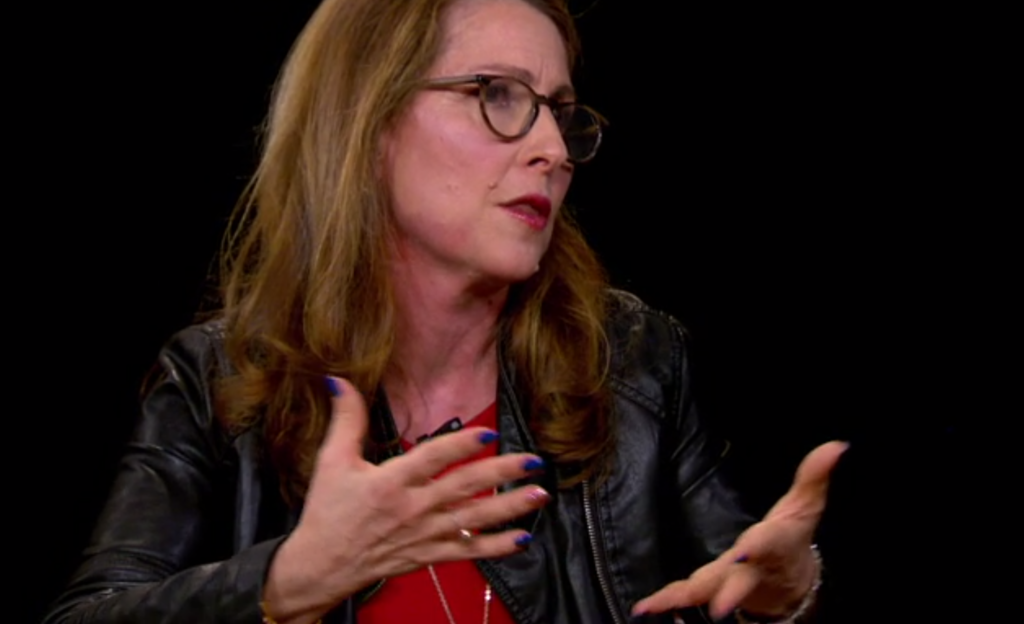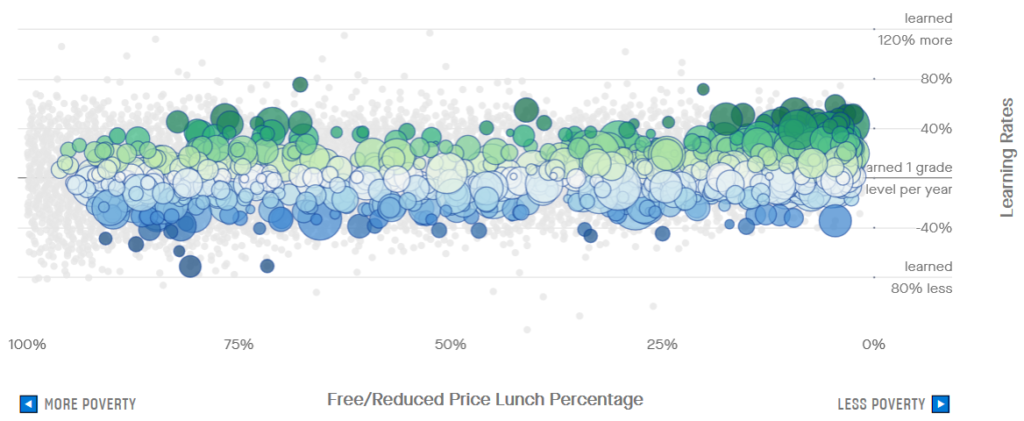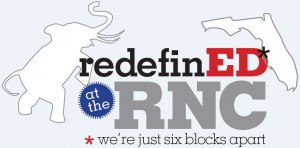During a 1916 football game between Georgia Tech and Cumberland, Georgia Tech coach John Heisman famously urged his players on to victory- “You're doing all right, team, we're ahead. But you just can't tell what those Cumberland players have up their sleeves. They may spring a surprise. Be alert, men! Hit 'em clean, but hit 'em hard!” Cumberland committed 15 turnovers in the game and had one of their players getting tackled for a six-yard loss on an attempt at an offensive rush declared their “play of the game.” Georgia Tech won the game 222 to 0.
This story has repeatedly come to mind repeatedly over the last decade while reading stories about the competition between surging Florida and floundering New York.
The New York Post reports that New York City Schools will spend $42,000 per student this year. Spending $840,000 on a classroom of 20 fourth graders might seem a bit pricey, especially given that judging on their 2024 NAEP performance, nine of them will be reading at “below basic.” New Yorkers must pay sky-high taxes to support the world’s most expensive illiteracy generator/job programs, which is one of the reasons so many New Yorkers keep becoming Floridians. Now, however, it isn’t just people and companies migrating from New York to Florida; New York’s Success Academy schools are also heading south.
Through the wizardry of Stanford’s Educational Opportunity Project graph generator, I’ve placed New York Success Academies (Marked 1-7) in the graph for the overall state of Florida for academic proficiency. Schools are dots; green dots are higher than average, blue below average, etc.
You don’t see many high-poverty schools (graph runs from low poverty on the right to high poverty on the left) with students scoring 3ish grade levels above average, but that is exactly what Success Academy has consistently delivered in New York.
Being a rational human, you might think that New York policymakers would be falling over themselves to get as many Success Academies operating as possible, but that is just you being silly again. New York lawmakers maintain a statewide cap on the number of charter schools. Apparently, New York lawmakers feel the need to keep safe from, well, learning.
Florida, on the other hand, does not have a cap on charter schools. Rather than treating highly successful schools specializing in educating disadvantaged students as a public menace, Florida is rolling out the red carpet for highly effective school models. Success Academy plans to open 40 schools in Florida over the next 10 years, something which New York law prohibits.
Is it too much? Too much winning? No, Florida, you have to win more! Or to paraphrase Coach Heisman “You're doing all right, Florida; you’re ahead. But you just can't tell what those New Yorkers have up their sleeves. They may spring a surprise. Be alert, men! Hit 'em clean, but hit 'em hard!” Capitalizing on the abject folly of New York policymakers is hitting both clean and hard.
When Florida lawmakers established the first statewide Charter School Review Commission in 2022.
 The National Association of Charter School Authorizers also weighed in, saying that forcing school districts into sponsorship of schools they didn’t authorize would cause district officials to disengage, weakening charter oversight.
The National Association of Charter School Authorizers also weighed in, saying that forcing school districts into sponsorship of schools they didn’t authorize would cause district officials to disengage, weakening charter oversight.
That was before Susie Miller Carello showed up. Before becoming executive director at the newly established Florida Charter Institute, she spent 12 years leading the Charter Schools Institute at SUNY, the largest higher-education authorizer in the country, and earned the moniker “America’s Authorizer.”
Under her leadership, New York choices, quadrupled enrollment, and significantly improved student achievement. By the end of her term, she helped authorize 221 schools that enrolled 120,000 students.
A 2023 study by the Center for Research on Educational Outcomes (CREDO) showed that New York, known for highly acclaimed charter networks such as Success Academy and Uncommon Schools, led the nation in outperforming their district school peers by the largest margins.
Carello’s job as chief of the Florida Charter Institute is to recommend to the seven-member statewide charter review commission whether to approve a proposed charter’s application or send the founders back to work on a plan that passes muster.
Since this institute began its work in 2023, would-be charter schools have submitted 22 applications. Just two made it to the commission for a vote. One of those was approved by the commission, the other rejected. Those who filed the other 20 withdrew their proposals after hearing Carello’s feedback.
“We’ve been very choosy,” Carello said. “We are committed to being very thorough and investigating the people who want to affect the lives of Florida children and gain access to millions in public funds to make sure they have not only a good design, but also that they have the capacity to put that good design in place.”
Statewide process more than a decade in the making
Efforts to establish a statewide review process that bypasses sometimes hostile local school boards stretch back nearly two decades. In 2008, a state appeals court struck down efforts to create a statewide charter school board like the ones in Massachusetts or Arizona.
In 2022, the Florida Legislature established the Florida Charter Schools Review Commission, with the institute as its administrative arm. The commission reviews applications from charter operators and authorizes them to operate. Once authorized, the local school district becomes the sponsor and supervisor for the charter school and is responsible for monitoring the school’s progress and finances and providing certain services.
The state also has now allowed state colleges and universities to authorize and operate charter schools.
Multiple pathways reduce the chances that school board politics could block a new school. State charter commissions also have specialized staff who evaluate charter schools full time, while school district officials are often burdened with other responsibilities.
The main charge from detractors was that allowing multiple pathways for charter schools would roll out the welcome mat for questionable operations. Two years in, that hasn’t been the case.
A statewide process also allows one-stop shopping for charter networks that seek to open locations in multiple counties instead of forcing them to file separate applications in each school district.
Newberry community rallies to support proposed new charter school
Carello’s and the commissioners’ high standards were on display at their first official meeting last month.
Carello presented two applications. The first came from the Newberry Community School in Alachua County, where a group of parents and teachers narrowly to turn the district elementary school to a charter school.
The Alachua County School Board opposed the application and has since voted to appeal the state Charter Review Commission’s unanimous approval to the state Board of Education.
However, Newberry city officials expressed strong moral and financial support. Former state Rep. Chuck Clemons, who represented the local House district, and other local leaders laid out the school plan, including a $2 million loan from the city and $180,000 in private donations. Teachers and staff would also receive pay raises that matched the district’s as well as the same benefits offered to city employees, including health insurance and a retirement plan. School employees enrolled in the Florida Retirement System would be allowed to remain.
The level of community support impressed commissioners.
“It was awesome to see the partnership that they have with the city of Newberry,” said Commissioner Sara C. Bianca, one of seven commissioners appointed by the state Board of Education in 2023. “The mayor of Newberry and two city commissioners were there, and they were just excited.”
Other Florida cities, like Cape Coral and Pembroke Pines, operate municipal charter networks, but Bianca said the structure of the Newberry partnership “feels unique,” and she’s curious to see if other cities follow suit.
‘Inconsistent and incomplete’
The second application, which commissioners unanimously denied, came from Bradenton Classical Academy, proposed as a Hillsdale College Barney Charter School. While Carello listed the Hillsdale affiliation as a strength, it wasn’t enough to give Bradenton the green light.
The evaluation form, signed by Carello, included concerns about its educational program design, which it said aligned poorly with state standards, and described staffing and budget plans as “inconsistent and incomplete.” The evaluation also cited the safety plan as “lacking in detail” and potentially jeopardizing student safety.
“Collectively, these gaps highlight the need for significant improvements before the school can be deemed operationally and academically viable,” the evaluation said.
Carello explained later that this was the second time Bradenton Classical had applied through the Florida Charter Institute after being denied by the Manatee County School District.
“They were victims of many different versions of the application,” Carello said. When leaders first applied, she said the institute offered advice and sent them back so they could improve the plan and resubmit for a better chance of approval.
She likened the best business plan to a spider web, where every strand is connected. When touched, the web might jiggle but still holds together.
The Bradenton Classical officials resubmitted a plan that didn’t “hang together.”
Though charter applicants must clear a high bar, the institute provides resources and support for a successful outcome. However, Carello never lowers that bar once a school wins approval.
“The charter initiative was to allow people to try out innovations. They got five years to try them out and if they made progress, that was great. And occasionally, there was a school that didn’t, and we closed them down.”
Florida's decade-long efforts to recruit more high-quality charter school operators to the state could be on the verge of a major breakthrough.
Tomorrow, the state Board of Education is set to consider an application from New York-based Success Academy as a designated Schools of Hope operator.
The Schools of Hope program was created in 2017 to help draw more high-performing charter school organizations to the Sunshine State. It scored a few successes, helping bring IDEA Public Schools to Jacksonville and Tampa, as well as KIPP to Miami.
Florida education leaders had for years bemoaned that major national nonprofit charter networks with strong track records of improving outcomes for low-income students had largely steered clear of the nation's third-largest state, despite a steadily growing charter school sector that now enrolls nearly 400,000 students.
One of the leaders working to make the state more friendly to top charter operators was then-state legislator Manny Diaz Jr., who is now the state's education commissioner.
Success fits the profile of operators Florida has long hoped to attract. Its schools boast the best math achievement in New York State while serving a student population of predominantly low-income children of color. All of its graduates get accepted to four-year colleges. The network is known for a relentless commitment to high expectations and celebrated efforts to deliver an academically demanding curriculum at scale.
But it's never opened a school outside New York City.
That may be about to change.
"We are immensely excited at the prospect of bringing our success to Florida and look forward to exploring what we can accomplish together, given that Florida is a national leader in educational choice, as the Schools of Hope program demonstrates," Success Academy's founder, Eva Moskowitz, wrote in a cover letter accompanying its Hope application. "Success believes its innovative model would translate well in Florida to bring further educational choice and opportunities to deserving Florida families."
Schools of Hope was designed to eliminate barriers for top charter operators, such as startup funding, facilities and local school board politics. In the just-completed legislative session, lawmakers set aside $6 million in funding to help Hope Operators with teacher training and startup costs.
The state's charter schools have scored other under-the-radar policy wins in recent years. The state created new exemptions from local zoning rules, convened a statewide authorizing commission, and is gradually phasing in close-to-equal per-student funding with district schools.
Combined with the state's continued enrollment growth, these policies have made Florida fertile ground for new charter schools.
New York's cap on the number of allowable charter schools has one of the state's best charter networks looking at other options for growth to help more students, including expansion to Florida, a state with a favorable policy environment, said Derrell Bradford, president of the education advocacy group 50CAN.
"Growth has been a priority for Success Academy for a very long time, because the network wants to give as many families access to a quality education, regardless of their ZIP code, as possible," said Bradford, who is also a member of the charter network's board.
Success has worked to spread its impact beyond the 53 schools it runs, publishing curriculum guides online and creating an education institute that offers training and resources for teachers.
"Right now, this is the best way for us to make sure that an example of what is possible exists beyond New York," Bradford said.
 Science writer Matthew Ridley has described the innovation process as one of trial and error in which individuals combine pre-existing techniques and/or technologies.
Science writer Matthew Ridley has described the innovation process as one of trial and error in which individuals combine pre-existing techniques and/or technologies.
One example: Horizontal drilling and hydraulic fracturing were around for many years before innovators figured out how to put them together to revolutionize the energy market.
Another example: Rick Astley’s “Never Gonna Give You Up” and Nirvana’s “Smells Like Teen Spirit” were around for decades before some unknown innovator combined them to create the greatest song in the English language.
Likewise, a new policy brief posted to the Arizona Charter Schools Association website suggests that combining project-based micro-schools with rigorous live distance learning can create a new path, to scale, for high-demand schools and can unleash new opportunities for teachers while addressing equity concerns with pandemic pods.
A Phoenix radio host interviewed a 44-year (!) classroom veteran teacher last year. The teacher observed that the main problem with education today isn’t a lack of funding, which he said has “always been tough.” The real problem, he said, is that “the joy of teaching has been strangled out of the profession.”
This can and must change, and combining small education communities with rigorous distance learning just might do the trick.
If you’ve ever visited a project-based learning micro-school, you quickly see the joy so sorely lacking in most education settings. With Sal Khan, founder of a free educational video library that allows blending learning, as your scout-troop/school leader, you’re watching an excited group of kids engaging in 3-D print design. An education guide leads students through some daily academic work on computers, but then the students tackle group projects.
I watched students engaged in 3-D print design at a Prenda micro-school on the Apache Nation in San Carlos Arizona. These kids were not just learning, they were learning and loving it. These types of schools have great potential because they do not require educators to raise funds for multi-million facilities.
This style of education, which took an early hold prior to the pandemic, has been thrust into the limelight now through the advent of pandemic pods. Educators can address equity concerns, such as a low-income family’s ability to pay teachers and gain access to computers, with enlightened public policy.
Success Academy of New York developed another innovation to pair with micro-schools. Success Academy changed the roles of instructional staff for distance learning, with teachers variously tackling the roles of lecturers and small group facilitator/student problem solvers.
The most skilled math instructor in the network gave a live internet broadcast lecture via the internet. Students divided into small groups to interact with teachers to discuss the material and work out issues. Teachers then graded and monitored student achievement and scheduled individual online tutoring sessions with struggling students.
The Success Academy distance learning model is itself potentially revolutionary. In theory, the network could offer this version of itself to both enrollment lottery winners and enrollment lottery losers. Many parents on the waitlist might very much prefer this option over a spot in a district that numbers rather than names schools.
Education, however, is very much a social enterprise for many, as most of us want and need access to instructors and classmates. We need community. The Arizona Center for Student Opportunity brief referenced above calls for educators to combine Prenda-style micro-schools with Success Academy-style distance learning programs.
This proposal could take a variety of forms. Education service providers could reach agreements with pandemic pod providers to “adopt” them into their distance learning programs. Alternatively, high-demand schools could gauge interest in creating pods among their current students and their waitlisted families.
Equity-related concerns connected to pandemic pods could be addressed through funding students. Private choice programs focusing on disadvantaged student populations, such as Florida’s scholarship programs, could be used to help low-income students and those with disabilities afford micro-schools. Alternatively, public school distance-learning statues could defer costs.
In Arizona, Prenda operates schools through district, charter and private choice mechanisms. All Prenda students take the state’s AZMerit exam, and students whose education is funded through district and charter mechanisms have their results factored into school ratings.
In partnering with a Success Academy-style distance learning provider, the “mothership” would provide the live lecture, while the small group facilitation function would be conducted by in-person by guides. Different flavors of micro-schools can be created through affiliation with different mothership institutions. Teachers can run the show rather than being part of all-too-often hugely indifferent bureaucracies. All we need are some trailblazing educators and enlightened policy.
To paraphrase the Gen-X bard:
“With the schools out, it’s less dangerous! Here we are now, liberate us! Don’t feel stupid or contagious! Here we are now, educate us!”

Eva Moskowitz, founder and chief executive of Success Academy Charter Schools, has been a teacher, a college professor, an elected official and chair of the New York City Council’s Education Committee.
Sweet are the uses of adversity,
Which, like the toad, ugly and venomous,
Wears yet a precious jewel in his head;
And this our life, exempt from public haunt,
Finds tongues in trees, books in the running brooks,
Sermons in stones, and good in everything.
I would not change it.
-- As You Like It, William Shakespeare
Brian Greenburg, CEO of the Silicon Schools Fund, produced this graphic to categorize varying levels of proficiency achieved by schools that launched impromptu distance learning at the outset of the COVID-19 pandemic. The graphic accompanied a post Greenburg wrote for EducationNext titled, “What we’ve learned from distance learning and what it means for the future.”
![]() The graphic’s horizontal axis organizes schools by general effectiveness: culture, teamwork, flexibility, quality. The vertical axis organizes schools by expertise with technology, low to high. In the worst-case pandemic scenario, you are a child enrolled in a school system with an ineffective bureaucratic culture and a poor grasp of technology. In the best-case scenario – a highly effective, flexible and technically proficient organization – your school quickly reorganized efforts around distance learning to produce high-quality distance instruction.
The graphic’s horizontal axis organizes schools by general effectiveness: culture, teamwork, flexibility, quality. The vertical axis organizes schools by expertise with technology, low to high. In the worst-case pandemic scenario, you are a child enrolled in a school system with an ineffective bureaucratic culture and a poor grasp of technology. In the best-case scenario – a highly effective, flexible and technically proficient organization – your school quickly reorganized efforts around distance learning to produce high-quality distance instruction.
New York’s Success Academy Charter Schools have been lauded for the high levels of academic proficiency achieved by high-poverty students. Stanford University’s Opportunity Explorer, for instance, shows Success Academy schools posting about three grade levels above average in academic proficiency, despite free and reduced-price lunch eligibility in the 74 to 90 percent range. Plotted against all available data in schools nationwide, this means Success Academy is not only breathing some very thin air in terms of performance, but also that it can lay claim to consistent excellent achievement.
The horizontal axis in the Greenburg chart was not an issue for Success Academy, and as it happens, neither was technological dexterity.

How did Success Academy tackle pandemic-induced distance learning? Well, the Philanthropy Roundtable was curious about that, so it interviewed founder and CEO Eva Moskowitz on how the schools rose to the pandemic challenge. You can watch the video here. What Success Academy pulled off seems potentially revolutionary, and Moskowitz is sharing learning resources free of charge.
I’ll give you my CliffsNotes version of the video.
The most effective lecturer in the entire network of schools on any given subject delivered live instructional lectures, while other teachers broke students into smaller groups online to facilitate group discussion and projects. Teachers monitored ongoing assignments to identify students who were falling behind and proactively required students to attend online remedial tutoring sessions.
In other words, Success Academy staff took great effort to keep students on track.
Why is this potentially revolutionary?
Because Success Academy and anyone else mastering these techniques may be able to offer it as an option to both admission lottery winners and losers in the future. It may be possible, for instance, to serve many students currently floundering in the bottom left quadrant in the Greenburg graphic through these techniques.
Exempt from public haunt, and more importantly, the need to provide very costly school space, a new path to quality and scale may beckon.
This crisis version of Success Academy distance learning should be viewed as a mere prototype. Success Academy and others doubtless will improve upon these techniques.
by Eva S. Moskowitz
Big. Bold. Fast. I constantly remind my team at Success Academy Charter Schools in New York City that as well as we are doing in rolling out new high-performing schools (we have one of the most ambitious plans in the nation) we can’t possibly move fast enough. While we now serve thousands of students with a better public education than they otherwise would have gotten, our city has hundreds of thousands of students who need better school options.
It isn’t possible to work as quickly or as urgently as this problem requires. Each year in my city, thousands of students are added to wait lists at high-performing charter schools and the city’s elite public school test-in programs. If you don’t get in, you have school choice but you have to either choose from among lousy zoned district schools, expensive private schools, or move to suburbia.
With the need for more great schools crystal clear in New York and around the country, it is absurd that we could even be having this national debate over whether or not there should be a federal role in education. Of course there should be a federal role, especially in the area of parent choice.
During the recent “I3” competitive grant competition and President Obama’s “Race To The Top” competition, we saw enormous leverage for reform from Washington. Many people didn’t know that leverage was possible, but the proof is in the pudding. States (many with Democratic governors) like Tennessee, New York, Illinois, and Massachusetts lifted caps on the creation of new charter schools – in large part because President Obama and Education Secretary Arne Duncan dared them to.
The Obama administration used its bully pulpit and a relatively small amount of federal money to incent smart, pragmatic policies at the state and local levels. The federal government ought to be able to do the same thing to incent urgency in statehouses, school districts, and on the ground in communities that desperately need good school options.
Bigger. Bolder. Faster. Yes, the federal government ought to be in a position to point its finger at states and districts and say, “Folks, we love you, but your kids are dying. You need to move faster!” At Success Academy Charter Schools, we see this as a moral imperative – the same moral imperative that led to the creation of Title I and IDEA, among other civil rights initiatives. Do federal legislators really think they can afford to sit silently, while the opportunities of another generation of students vanishes? (more…)
Oh how the blog gods have smiled down upon redefinED.
The 2012 Republican National Convention will be held in downtown Tampa this month – six blocks from the building that houses Step Up for Students and our humble blog. I received press credentials to cover the convention. And next week, as a lead-up to the event, we’ll be posting essays from some of the leading voices in school choice and education reform.
Here’s the line up: former U.S. Secretary of Education Margaret Spellings; Chester E. Finn, Jr., president of the Thomas B. Fordham Institute; Robert C. Enlow, president and CEO of the Friedman Foundation for Educational Choice; Joe Williams, executive director of Democrats for Education Reform; Michael B. Horn, executive director for education at the Innosight Institute; and Eva S. Moskowitz, founder and CEO of Success Academy Charter Schools.
With the RNC and November elections as a backdrop, we asked our contributors what – if anything – the federal government can do to promote school choice. It goes without saying that the responses are thoughtful, insightful and informative. They’re also diverse. They’ll give you plenty to think about – and even a few things to laugh at.
First up Monday: Secretary Spellings.